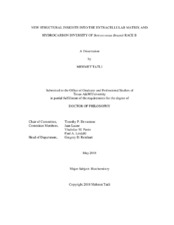| dc.description.abstract | Botryococcus braunii is a colonial green microalga that can produce large amounts of liquid isoprenoid hydrocarbons known as botryococcenes, which can be easily converted into conventional combustion engine fuels. B. braunii colony cells are held together by a complex extracellular matrix (ECM). ECM serves as a storage unit for liquid hydrocarbons, and contains a retaining wall and a polysaccharide fibrillar sheath. Analysis of “shells” revealed a single protein. Here we use peptide mass fingerprinting and bioinformatics to identify this protein called polysaccharide associated protein (PSAP). PSAP does not show similarity to any protein in databases, and contains several hydroxyproline domains and a predicted sugar binding domain. Staining studies confirm PSAP as a glycoprotein, and mass spectrometry analysis identified ten N-linked glycosylation sites comprising seven different glycans containing mostly mannose and N-acetylglucosamine with fucose and arabinose. Additionally, four hydroxyproline residues have short O-linked glycans of mainly arabinose and galactose, with 6-deoxyhexose. PSAP secretion and localization to shell material is confirmed using western blot analysis and microscopy. These studies indicate PSAP contains unique glycans and suggest its involvement in ECM polysaccharide fiber biosynthesis.
Moreover, B. braunii is capable of producing many botryococcene isomers ranging in carbon number from 30 to 37, as well as several methylated squalenes. Although studies have reported the isolation of isomers based on the C31, C32, C33, and C34 botryococcene structures, there has not been a report of cyclic C33 botryococcenes or an isomer based on the trimethylsqualene structure until this study. Three cyclic C33 botryococcenes and one new trimethylsqualene isomer were isolated from the B race, Showa (Berkeley) strain of B. braunii.
In addition, a detailed examination of the molecular structure for ten botryococcenes including the newly discovered cyclic C33 botryococcenes and five methylsqualenes isolated from race B was carried out using Raman spectroscopy and density functional theory (DFT) calculations in an effort to distinguish between these structurally similar molecules by spectroscopic approaches. A comparison of the experimental Raman spectroscopy and DFT calculations indicates several spectral regions such as those for ν(C=C) stretching, CH2/CH3 bending, and ring bending can be used to distinguish between these molecules. Altogether, these studies bring more insights into understanding the hydrocarbon diversity and ECM of B. braunii race B. | en |


